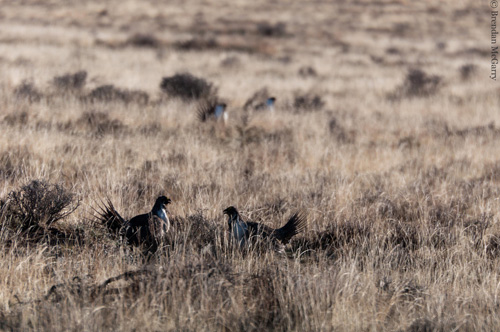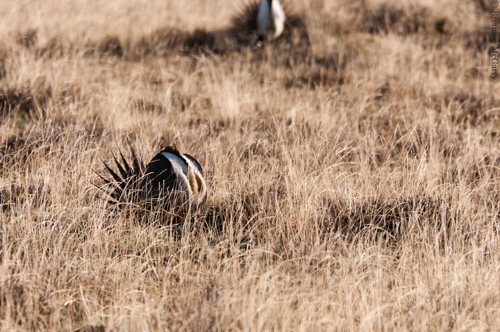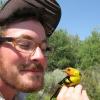

Join BirdNote tomorrow, November 30th!
Illustrator David Sibley and actor H. Jon Benjamin will face off in the bird illustration battle of the century during BirdNote's Year-end Celebration and Auction!
It was March, and some time before dawn, I was driving a van full of birders down a gravel backroad of Southeastern Oregon. The dirt track slid under us disconcertingly, like a thin layer of wet snow. When rain falls heavily on ground only half prepared for absorption, a sickly alluvium forms. We'd been warned such mud could make for disaster. However, there'd been no rain overnight, and at 3:50 AM, a collective decision was made: Let's hit the road. Yes, we were still in pajamas and the twin beds seemed, at that moment, the most luxurious in the world. Still, there was a greater pull.

A vague hint of a slaty first light began to push over the horizon. The windows were rolled down, and the Horned Larks were audible in dawn chorus. They were also apparently sleeping in the middle of the road, groggily or stubbornly flushing only seconds before our tread.
After eight squelching, sliding, jostling miles, we crept to a halt. It was about 5:00 AM, and we should have been able to hear what we came for. We didn't.
“Turn off the engine. I can't hear anything.”
“Vesper Sparrow. Horned Lark. Meadowlark.” I grasped for other sounds in the inky depths.
“Stop crinkling that granola bar wrapper.”
A frumpy bird flew across the road. Our pulses quickened, and I immediately cut the engine. Still nothing. I was starting to worry.

As if by magic, our eyes adjusted in the still waxing light. Something, uncannily like a pillow filled with matching balloons, was pirouetting about outside. We started to notice these queer shapes all over in the twilight.
Out in the sagebrush, bizarre noises echoed around. It sounded as if people wearing corduroys were alternating between running and resting on elliptical machines, their inner thighs rubbing together audibly for protracted periods. As the pants rubbed, the people were desperately clutching milkshakes and the viscous liquid was popping about in odd percussion inside the cups. This is a perfect example of why written descriptions of avian sounds are impossible, why they pale in comparison to a recording or the real thing.
Jokes aside, what was really happening out there? Why had three other volunteers and I driven five high-school-aged birders down a sketchy, muddy road in the dark at 4:00 in the morning? We had good reason, because in reality, the apparitions, only meters from our van, were Greater Sage-Grouse (Centrocercus urophasianus) in strutting display. This was their lek, a place where males gather to show off for females in the hope of mating. We were attending one of most magical avian displays in North America.
The noises we were hearing were partially from two esophageal pouches, which swell in males as the breeding season approaches. Males fill these pouches with air, till it looks as if twin balloons are protruding from their chests. And as they do so, they swish their wings against the feathers of their neck and breasts. The air-sacs plop (like those milkshakes), and the wings rub against the chest to create the swish (those corduroys). Other noises are interspersed but not as easily heard.

There were nearly thirty males strutting about, amply bosomed and obviously thoroughly out of their minds on testosterone. Several of the males in central locations fought over space, displaying at each other with the occasional physical attack. This system is complicated and nuanced. Basically, males in their prime come together to display, but only a few of these males are actually chosen by females as mates. (The females, having mated, will nest and raise young completely on their own.) We noticed that the males in the middle of the lek seemed more active, both fighting more and displaying with more frequency. The best of the best?
These birds, our largest grouse, are long-lived and were once widespread west of the Rockies. Sadly they've been in decline for some time now, due to a number of pressures, mostly revolving around habitat loss. We were lucky to witness the display at all.
The sun began to creep higher, casting a harsh glare across the display grounds. Soon, the males would be flying off for the day, to return in the early hours the following morning. And before long, these grounds would be quiet until next March, when the strutting would begin anew. We'd been perched in our van for nearly three hours, and I was pretty sure I was getting deep vein thrombosis. It was time to slide on off and leave these outrageous birds to their shrubs and their flaunting.

